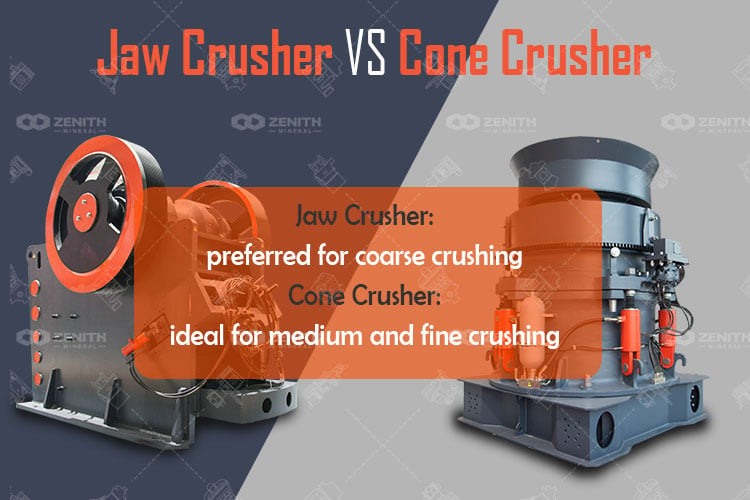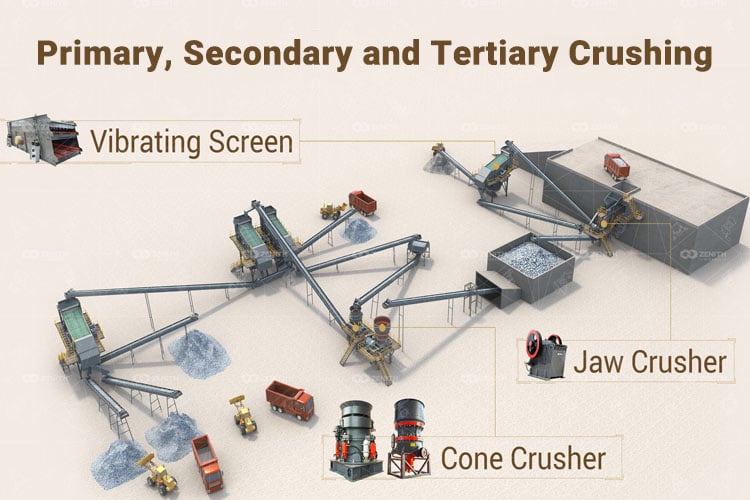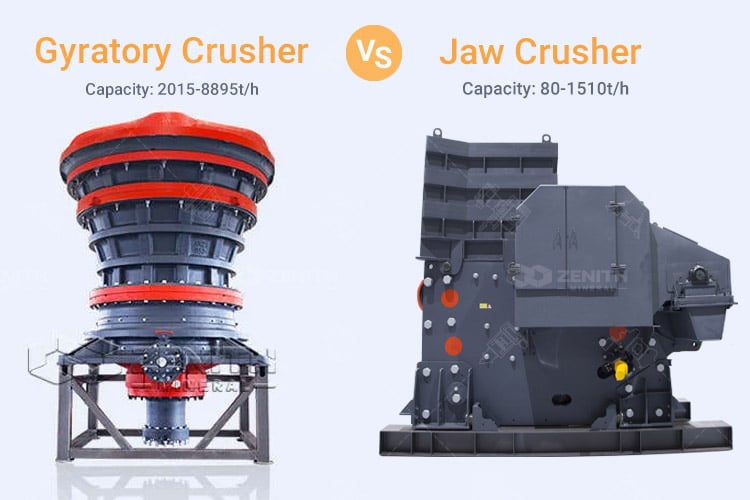Choosing the Right Primary Crusher: Jaw, Gyratory, or Impact Crusher
Primary crushers play a crucial role in the material processing chain, as they are responsible for reducing large rocks and minerals into smaller, more manageable sizes for secondary crushing or direct application. The choice of a primary crusher can significantly impact the efficiency and cost-effectiveness of a crushing operation. Jaw crusher, gyratory crusher and impact crusher are the best equipments for primary crushing due to their unique working principles and optimal applications.
The main function of the primary crusher
- Engineered to accept exceptionally large feed sizes without risk of clogging
- Effectively reduce massive lumps to conveyor-compatible dimensions
- Establish optimal conditions for subsequent processing stages
This article will discuss three common types of primary crushers—jaw crushers, gyratory crushers, and impact crushers—along with guidelines for selecting the right one for specific applications.
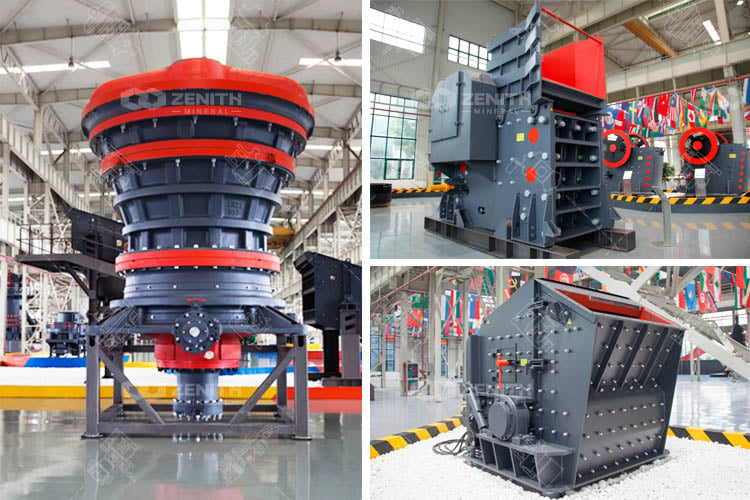
Jaw Crusher
Jaw crushers are one of the most widely used primary crushers due to their simple design, versatility, and ability to handle a variety of materials. They operate by compressing the material between a fixed jaw and a moving jaw, which oscillates to crush the material into smaller pieces.
Design and Working Principle
The jaw crusher consists of two main components: a fixed jaw plate and a movable jaw plate. The movable jaw moves back and forth in a V-shaped cavity, crushing the material by compressive force. The crushed material exits at the bottom of the crusher.
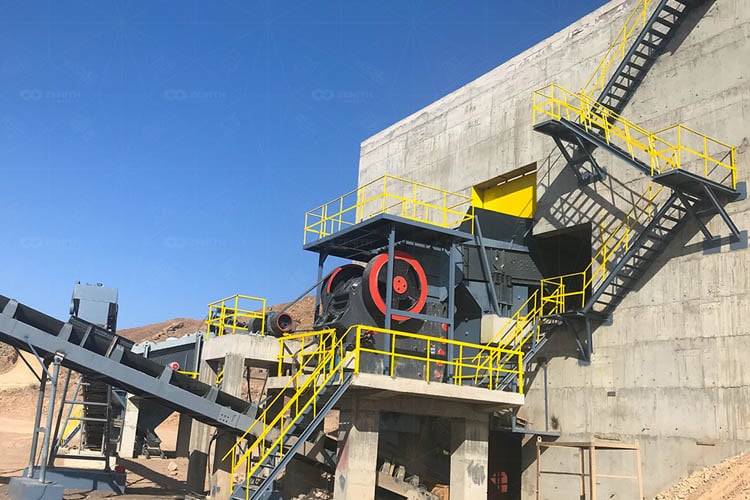
Key Features
- Crushing Mechanism: Compression
- Feed Size: Typically up to 1,500 mm (60 inches)
- Output Size: Adjustable, usually between 10 to 350 mm
- Capacity: From 1 to 1,000 tons per hour depending on model and material
- Construction: Robust and simple design, easy maintenance
- Applications: Suitable for hard and abrasive materials such as granite, basalt, and ores
Advantages
- ✅Simple structure and reliable operation
- ✅High crushing ratio and uniform product size
- ✅Suitable for a wide range of materials, including hard and abrasive rocks
- ✅Lower operating costs and energy consumption
Limitations
- ❌Limited throughput capacity compared to gyratory crushers
- ❌Not ideal for sticky or clayey materials that can clog the crushing chamber
- ❌Requires regular maintenance of jaw plates
2. Gyratory Crusher
Gyratory crushers are heavy-duty primary crushers commonly used in large-scale mining and quarrying operations. They crush rock by applying compressive force through a gyrating spindle that is covered by a wear-resistant mantle.
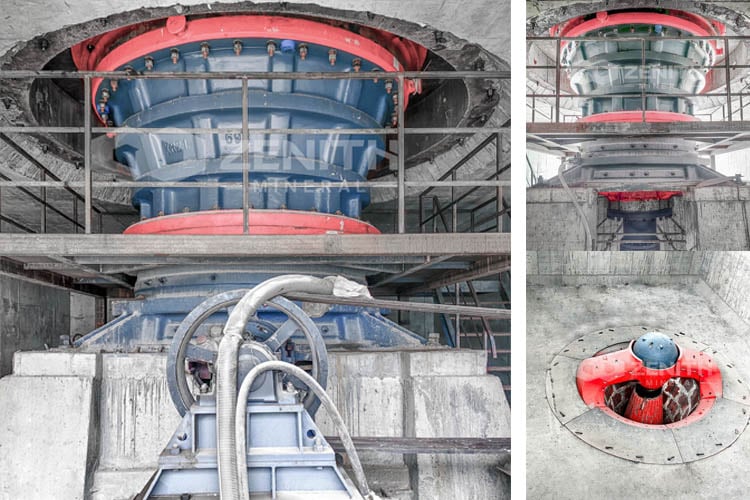
Design and Working Principle
A gyratory crusher consists of a concave surface and a conical head, both lined with manganese steel. The conical head gyrates inside the concave, crushing the material between the mantle and concave by compressive force.
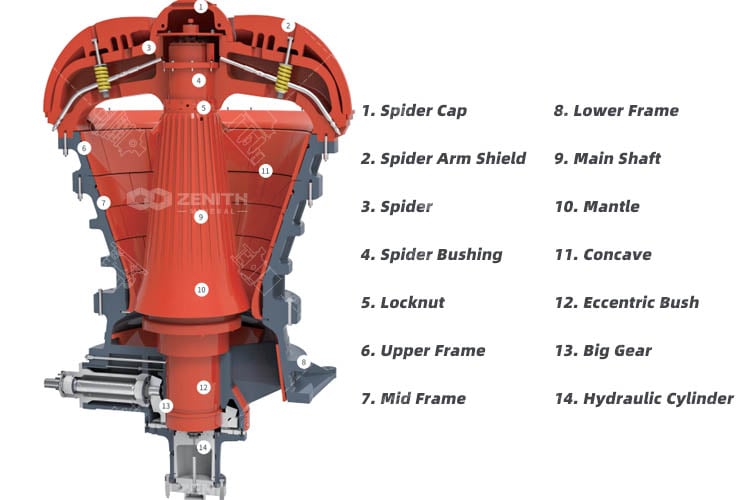
Key Features
- Crushing Mechanism: Compression
- Feed Size: Can handle very large feed sizes, often exceeding 1,500 mm.
- Output Size: Adjustable, typically between 50 to 300 mm
- Capacity: Very high, from 1,000 to over 5,000 tons per hour
- Construction: Large, heavy, and complex structure requiring skilled maintenance
- Applications: Ideal for hard, abrasive, and large feed materials such as granite, basalt, and iron ore
Advantages
- ✅High capacity and continuous operation suitable for large-scale projects
- ✅Uniform product size and high reduction ratio
- ✅Can handle very large feed sizes without pre-screening
- ✅Durable and long service life with proper maintenance
Limitations
- ❌High initial investment and installation cost
- ❌Large footprint and complex foundation requirements
- ❌Requires skilled operators and maintenance personnel
- ❌Not suitable for sticky or clayey materials
Impact Crusher
Impact crushers utilize impact force to crush materials. They are typically used for softer, less abrasive materials but can also be employed as primary crushers in certain applications.
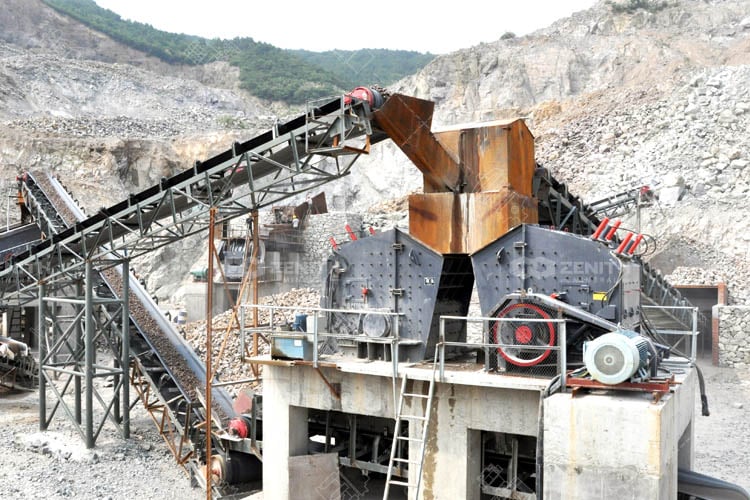
Design and Working Principle
Impact crushers consist of a rotor with hammers or blow bars that rotate at high speed inside a crushing chamber. Material is fed into the chamber and impacted by the hammers, causing it to shatter upon collision with impact plates or aprons.
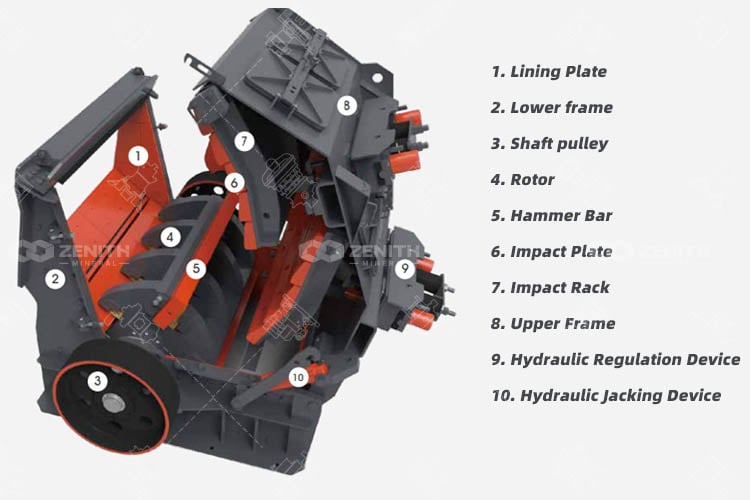
Key Features
- Crushing Mechanism: Impact (dynamic force)
- Feed Size: Generally smaller than jaw and gyratory crushers, up to 1,000 mm
- Output Size: Adjustable, typically from 10 to 100 mm
- Capacity: Medium, from 50 to 1,000 tons per hour
- Construction: Simple design with wear parts subject to frequent replacement
- Applications: Suitable for softer materials like limestone, coal, and gypsum; also used for recycling concrete and asphalt
Advantages
- ✅High Reduction Ratio: Impact crushers can achieve a high reduction ratio, making them effective for medium to hard materials.
- ✅Cubic Product Shape: The output from impact crushers is often cubical, which is desirable for many applications.
- ✅Low Wear Costs: With the right materials, the wear costs associated with impact crushers can be lower than those of jaw or gyratory crushers.
Limitations
- ❌Wear parts (hammers, blow bars) have a shorter lifespan, increasing operational costs
- ❌Not ideal for very hard or abrasive materials
- ❌Lower capacity compared to gyratory crushers for large feed sizes
- ❌Excessive fines generation in some cases
How to Choose the Right Primary Crusher
Selecting the appropriate primary crusher depends on several critical factors related to the material, production requirements, and operational constraints.
1. Material Characteristics
- Hardness and Abrasiveness: Jaw and gyratory crushers are better suited for hard, abrasive materials. Impact crushers are preferable for softer, less abrasive materials.
- Moisture Content: Impact crushers can handle materials with higher moisture content better than jaw or gyratory crushers.
- Stickiness and Clay Content: Materials with high clay or stickiness may clog jaw and gyratory crushers. Impact crushers or pre-screening may be required.
2. Feed Size and Capacity
- Feed Size: Gyratory crushers can handle the largest feed sizes, followed by jaw crushers. Impact crushers generally require smaller feed sizes.
- Capacity Requirements: For very high throughput (thousands of tons per hour), gyratory crushers are preferred. Jaw crushers suit medium capacities, while impact crushers fit lower to medium ranges.
3. Desired Product Size and Shape
- Product Size: Jaw and gyratory crushers provide adjustable output sizes but may produce more elongated particles. Impact crushers produce more cubical and uniform particles, which is beneficial for certain applications.
- Fines Generation: Impact crushers tend to generate more fines, which may or may not be desirable.
4. Operational Considerations
- Installation and Footprint: Jaw crushers have a smaller footprint and simpler installation compared to gyratory crushers.
- Energy Consumption: Jaw crushers typically consume less energy than impact crushers for hard materials.
- Mobility: Jaw and impact crushers are more adaptable to portable or mobile crushing plants.
5. Economic Factors
- Initial Cost: Compare the initial purchase price of the crushers. Jaw crushers are typically less expensive than gyratory crushers.
- Maintenance and Operating Costs: Jaw crushers are generally easier and cheaper to maintain. Impact crushers have higher wear parts costs. Gyratory crushers require skilled maintenance but offer longer service life.
Comparison of Primary Crushers
| Feature |
Jaw Crusher |
Gyratory Crusher |
Impact Crusher |
| Crushing Mechanism |
Compression |
Compression |
Impact |
| Feed Size (max) |
Up to 1,500 mm |
Up to 2,500 mm |
Up to 1,000 mm |
| Capacity Range |
1 – 1,000 tph |
1,000 – 5,000+ tph |
50 – 1,000 tph |
| Product Size |
Adjustable, 10 – 350 mm |
Adjustable, 50 – 300 mm |
Adjustable, 10 – 100 mm |
| Material Hardness |
Hard and abrasive |
Very hard and abrasive |
Softer, less abrasive |
| Moisture Handling |
Poor |
Poor |
Good |
| Maintenance |
Moderate |
Complex |
High (wear parts) |
| Energy Consumption |
Low |
Moderate |
High |
| Installation Complexity |
Simple |
Complex |
Simple |
| Product Shape |
Elongated |
Uniform |
Cubical |
| Cost |
Low to moderate |
High |
Moderate |
Choosing the right primary crusher is a critical decision that affects the efficiency, cost, and success of a crushing operation.
- Jaw crushers are ideal for medium to hard materials with moderate capacity requirements and simpler operational settings.
- Gyratory crushers suit large-scale operations with very high capacity needs and large feed sizes, especially for hard and abrasive materials.
- Impact crushers are best for softer materials, applications requiring good product shape, and operations with moderate capacity.
Understanding the material properties, production goals, and operational constraints will guide you in selecting the optimal primary crusher.






